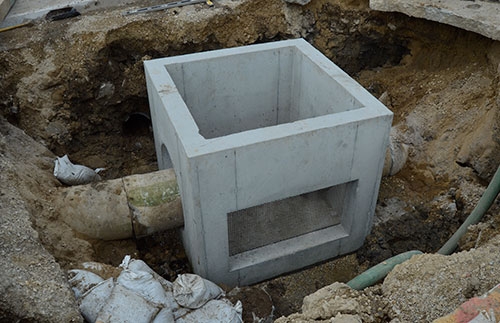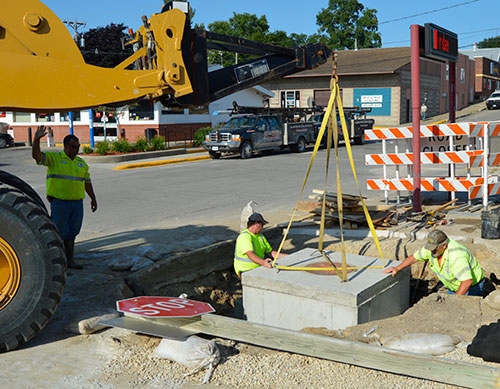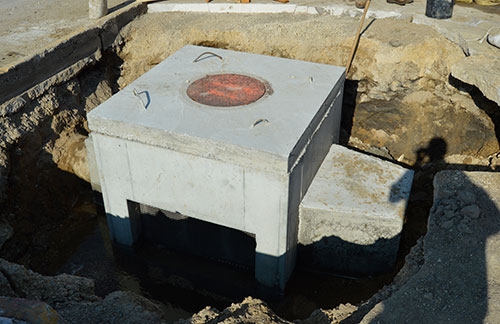You are here
Home ›Project diverting underground spring into storm sewer along Spring Avenue nearly complete

The spring in Spring Avenue will now remain an underground operation ... The surrounding photos show the progress made with the installation of a pre-cast concrete box intake near the intersection of Spring Avenue and First Avenue SW in downtown Waukon. The concrete structure was installed to divert the freshwater underground spring into the storm sewer, rather than allowing the spring to surface at street level as it has been in most recent years. The pre-cast intake box is pictured above in place and connected to a storm sewer pipe along Spring Avenue. The rectangular screen in the foreground of the photo will allow the freshwater spring to flow into the storm sewer while not affecting the functionality of the storm sewer. In the photo below at left, City of Waukon Street Superintendent Keith Burrett and his crew are pictured guiding the lid of the pre-cast intake box as it is lowered in place. The lid of the pre-cast intake includes a manhole cover (as pictured below at right), allowing access for future maintenance of the intake, with the surrounding open area filled with crushed rock and scheduled to be paved over top to finish off the project. Standard photos by Joe Moses.


by Joe Moses
An area near the intersection of First Avenue SW and Spring Avenue in downtown Waukon has been barricaded with orange safety fencing for several weeks this summer as City crews and other professionals have developed and installed a solution to the flow of a freshwater spring that has surfaced in that area over the past several years.
The natural spring flowing under Spring Avenue has been documented throughout Waukon’s history with references dating back to the 1896 installation of a horse trough at the head of Spring Avenue, which took advantage of this natural water source. Due to heavy rainfall in recent years, this freshwater spring has created a bubbling effect near this intersection as spring water would flow from below ground to street level and then into the storm sewer.
This water flow had created some concerns relating to the possible erosion of the soil base structure under the pavement, which was a motivating factor in addressing this issue prior to the 2019 Iowa Department of Transportation (DOT) street project and additional repaving projects planned elsewhere in conjunction with that project.
Senior Project Manager and City Engineer Lyle TeKippe of Fehr-Graham Engineering, West Union has indicated that the drainage route for the spring changed following the flooding that took place in the Waukon area in 2013 with the spring’s path of least resistance now leading to the surface. In response to this change, the City of Waukon has worked with Fehr-Graham Engineering in developing a drainage solution allowing the spring to remain underground and flow directly into the City’s storm sewer.
The process began earlier this summer with excavation at the corner of Spring Avenue, exposing a section of storm sewer running north and south with the natural spring flowing underground from the east, pooling in the area dug out next to the storm sewer pipe. TeKippe indicated that a rectangular opening on the top of the storm sewer pipe was cut out as a temporary measure, allowing the freshwater spring to drain into the storm sewer, while a pre-cast concrete box with a metal screen was ordered. TeKippe explained that the pre-cast box was chosen rather than pouring a concrete structure due to moisture and pooling of spring water in the area excavated.
The pre-cast intake was lowered into the excavated area, connecting the storm sewer pipe where a small section had been removed in preparation for this structure. The pre-cast intake includes a rectangular metal screen to accommodate the flow of the spring from the east.
TeKippe indicated that the area around the concrete pre-cast box was filled with large crushed rock, which provides sufficient space or voids between rocks to allow the spring water flow to enter the intake and continue into the storm sewer, not affecting the normal flow of the storm sewer. With the intake now in place and the excavation area filled with large rock, TeKippe indicated that the City will be completing the project by paving around the lid of the pre-cast intake and manhole cover at a future date.

